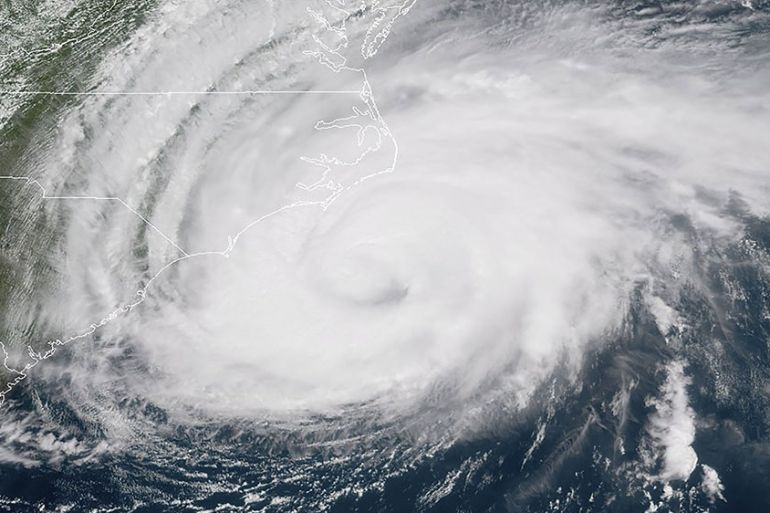Hurricane Florence edges closer with life-threatening storm surge
Outer edges of Florence, now Category 1 storm, reach North Carolina with centre of hurricane expected to hit on Friday.

The outer reaches of Hurricane Florence began lashing coastal North Carolina with heavy winds and flooded roads on Thursday ahead of an expected landfall that will bring walls of water and lingering downpours to parts of the US East Coast.
The centre of Florence, which has been downgraded to a Category 1 storm, is expected to hit North Carolina’s southern coast on Friday, then drift southwest before moving inland on Saturday, enough time to drop as much as one metre of rain in some places, according to the National Hurricane Center.
Keep reading
list of 4 itemsPhotos: Flash floods in Afghanistan devastate lives and livelihoods
At least 28 dead, several missing in Indonesia flash floods, cold lava flow
More than 300 killed in Afghanistan flash floods
An estimated 10 million people live in the storm’s path, according to the US Weather Prediction Center, and coastal businesses and homes were boarded up in anticipation. More than one million people had been ordered to evacuate the coasts of North and South Carolina and Virginia and thousands moved to emergency shelters, officials said.
Al Jazeera’s Jay Gray, reporting from Carolina Beach in North Carolina, said the situation is going to “intensify as the storm moves closer to the shore line”.
Hurricane #Florence is producing a life-threatening storm surge and hurricane conditions over portions of eastern North Carolina. The threat of freshwater flooding will increase and spread inland over the next several days. https://t.co/tW4KeGdBFb pic.twitter.com/3OokbkFeb7
— National Hurricane Center (@NHC_Atlantic) September 14, 2018
“In some areas, these conditions are going to continue for two days or more,” he said. “This is setting up to be a historic flooding in some of the low areas across the strike zone.”
Florence’s maximum sustained winds were clocked on Thursday at 165 kilometres per hour after it was downgraded to a Category 2 on the five-step Saffir-Simpson scale, according to the NHC. The winds had been as high as 140 miles per hour (roughly 225kph) earlier in the week.
But North Carolina Governor Roy Cooper warned: “Don’t relax, don’t get complacent. Stay on guard. This is a powerful storm that can kill. Today the threat becomes a reality.”
https://twitter.com/SEREF737/status/1040497957957775360?ref_src=twsrc%5Etfw
Some people who had rejected calls to evacuate the area in danger area took walks along the water as they tried to enjoy a few final hours of normalcy before Florence’s fury arrived.
In Sea Breeze, Roslyn Fleming, 56, made a video of the inlet where her granddaughter was baptised because “I just don’t think a lot of this is going to be here” after the storm, she told Reuters news agency.
Sixteen kilometres away in the city of Wilmington, wind gusts were stirring up frothy white caps into the Cape Fear River.
![A man walks past a boarded-up business before Hurricane Florence comes ashore in Wilmington, North Carolina [Carlo Allegri/Reuters]](/wp-content/uploads/2018/09/91195283acb34d85910b17ea82e056b7_18.jpeg)
“We’re a little worried about the storm surge so we came down to see what the river is doing now,” said Linda Smith, 67, a retired nonprofit director. “I am frightened about what’s coming. We just want prayers from everyone.”
Flooding, power outages begin
The storm’s centre was about 180km east of Wilmington, North Carolina, at 2pm local time (18:00 GMT) but tropical storm-strength winds and heavy rains already were hitting North Carolina’s Outer Banks barrier islands. The main highway in the Outer Banks was closed in parts as seawater pushed in. Flooding from rain and rising rivers also was reported in New Bern.
Some 11,000 power outages have been reported in North Carolina.
The hurricane centre also said the threat of tornadoes was increasing as the storm neared the shore.
![The Union Point Park Complex is seen flooded as the Hurricane Florence comes ashore in New Bern, North Carolina [Eduardo Munoz/Reuters]](/wp-content/uploads/2018/09/d5579796f53c4b4f84f90e3e90bcc8e9_18.jpeg)
Florence could bring wind-driven storm surges of seawater as high as four metres and NHC Director Ken Graham said on Facebook they could push in as far as three kilometres. Heavy rains were forecast to extend into the Appalachian mountains, affecting parts of Alabama, Tennessee, Kentucky, and West Virginia.
The storm will be a test of President Donald Trump’s administration less than two months before elections to determine control of the United States Congress. After criticism for its response to last year’s Hurricane Maria in Puerto Rico, which officials there said was responsible for 3,000 deaths, Trump has vowed a vigorous response to Florence and defended his handling of Maria.
“3000 people did not die in the two hurricanes that hit Puerto Rico,” Trump said on Twitter. “When I left the Island, AFTER the storm had hit, they had anywhere from 6 to 18 deaths … Then, a long time later, they started to report really large numbers, like 3000.”
Trump provided no evidence to support his challenge on Maria.
Emergency declarations were in force in Georgia, South and North Carolina, Virginia, Maryland and the District of Columbia. Millions of people are expected to lose power and it could take weeks to resolve the outages.
![Water from Neuse River floods houses as Hurricane Florence comes ashore in New Bern, North Carolina [Eduardo Munoz/Reuters]](/wp-content/uploads/2018/09/8d03914c23fc45a2aba4afbf67f50621_18.jpeg)